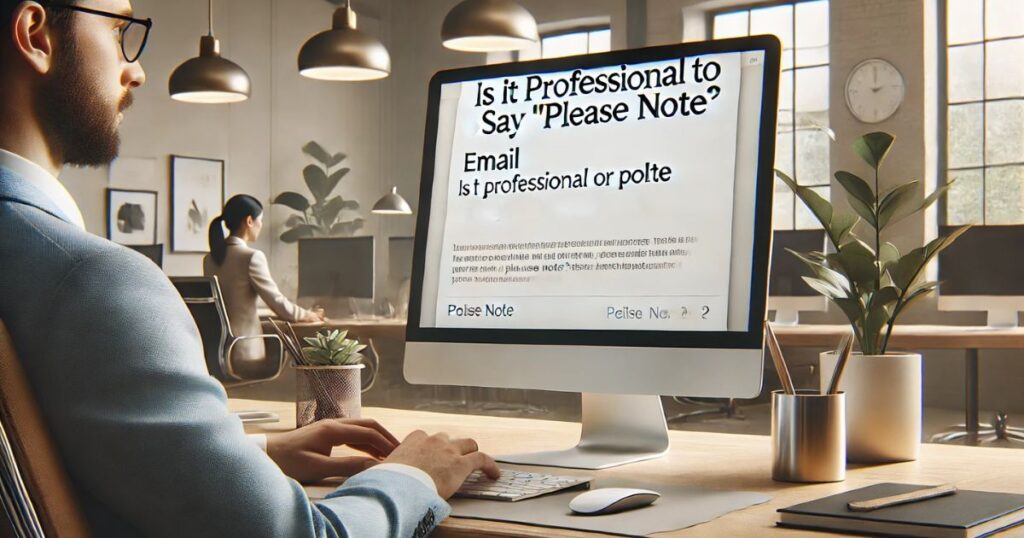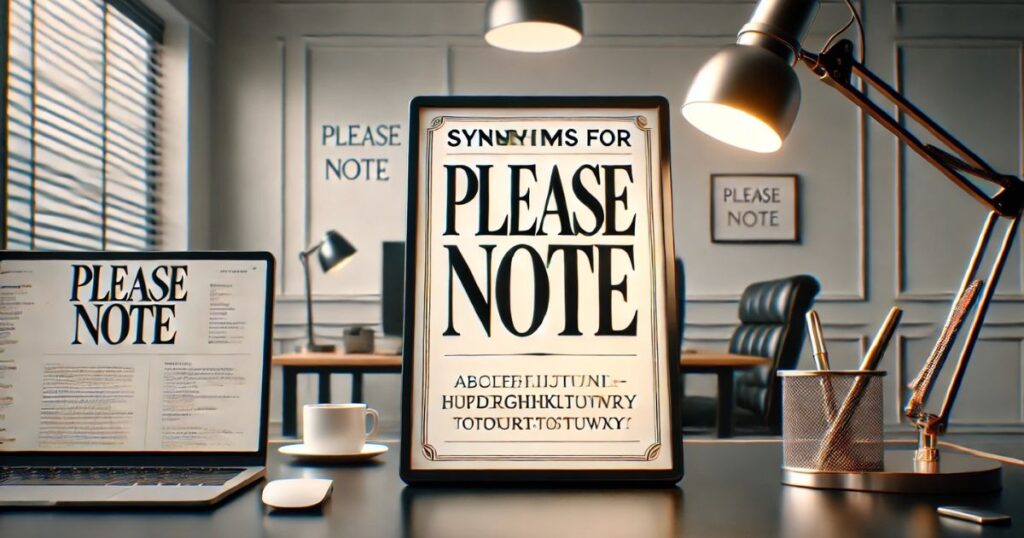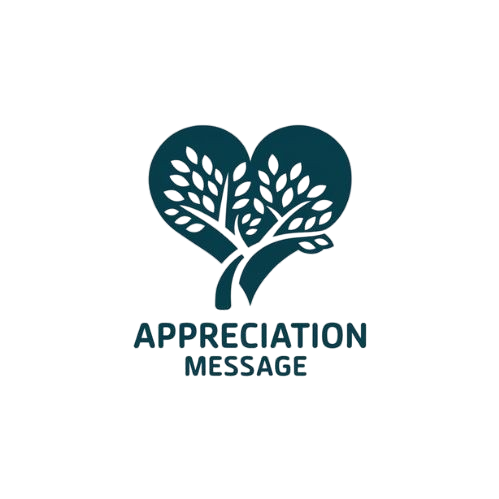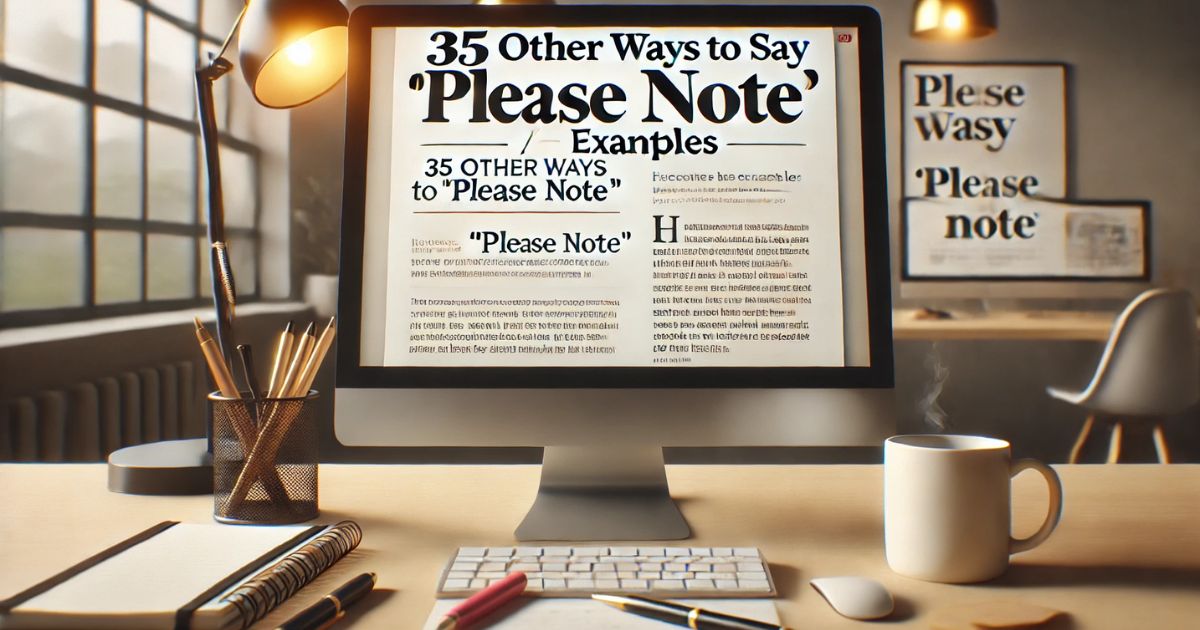Please note that this phrase helps highlight key details in messages. It tells readers to pay attention. But what does please note mean exactly? It simply means to be aware of something important. Many use it in emails, documents, or signs to emphasize critical points.
There are other ways to say please note that can sound more natural or professional. Choosing another word for please note can improve clarity and engagement in writing. If you’re wondering, what does please note mean, it’s a polite way to direct attention to important details. Understanding please note meaning helps improve communication. In this article, we’ll discuss other ways to say please note and when to use them. Using different phrases keeps your writing fresh and professional. Whether in business, academics, or casual writing, choosing the right words makes a difference.
What Does “Please Note” Mean?
Please note is a phrase that tells someone to pay attention to important information. It helps make sure people understand something clearly. You will often see it in emails, signs, or instructions. It helps highlight details that should not be ignored or forgotten.
This phrase is useful when giving directions, warnings, or important updates. For example, in an office email, someone might write, “Please note that the meeting has been rescheduled.” This ensures that everyone notices the change. It is a polite and clear way to communicate.
Please note the meaning is simpleit asks the reader or listener to focus. If you miss this information, you might get confused later. That’s why businesses, teachers, and even websites use it often. It makes sure people read and understand important messages quickly and easily.
Is It Professional or Polite to Say “Please Note”?

Yes, please note it is both professional and polite. It is often used in workplaces, legal documents, and formal messages. It keeps the tone respectful while making the message clear. It is not rude, but rather a helpful way to highlight something important without sounding too demanding.
Many professionals use please note in emails and reports. For example, “Please note that payment is due by Friday.” This reminds the reader without being too direct or harsh. It ensures that the person understands the message without feeling pressured or uncomfortable.
If you want another word for please note, try “Be aware” or “Keep in mind.” These phrases are also polite but feel slightly more casual. No matter which phrase you use, the goal remains the sameto make sure the reader pays attention to key details.
Advantages and Disadvantages of Saying “Please Note”

Using “please note” has its pros and cons. It helps highlight important information, ensuring the reader pays attention. This phrase is polite, professional, and commonly used in formal writing. However, overusing it can make your writing sound repetitive or overly strict. Some may find it unnecessary, as the context often makes the point clear. If you want another word for please note, try “keep in mind” or “be aware.” Understanding please note meaning helps you decide when to use it effectively. There are many other ways to say please note, so varying your language keeps communication fresh and engaging.
Advantages of Saying “Please Note”
- Grabs Attention – It highlights key information, making sure the reader doesn’t miss important details.
- Polite and Professional – The phrase sounds courteous and works well in formal communication.
- Provides Clarity – It helps emphasize crucial points, reducing misunderstandings.
- Easy to Understand – Simple and widely recognized, making it effective in both casual and business settings.
- Sets the Right Tone – It gently instructs the reader without sounding too forceful or demanding.
Disadvantages of Saying “Please Note”
- Overused and Repetitive – Frequent use can make writing seem dull or unoriginal.
- Can Sound Formal – In casual conversations, it may feel too stiff or unnatural.
- Unnecessary in Some Contexts – Often, the message is clear without needing extra emphasis.
- Might Seem Condescending – Some readers may feel like they are being talked down to.
- Lacks Variety – Sticking to one phrase repeatedly can weaken your writing’s impact.
Read Also: 35 Other Ways to Say ‘Netflix and Chill’ (With Examples)
Synonyms for “Please Note”

- Kindly be aware that this important information requires your immediate attention and careful consideration.
- Take notice that the following details are crucial for your understanding and necessary action.
- Be informed that this statement contains essential facts that should not be overlooked.
- It is important to acknowledge this message as it contains valuable and necessary details.
- Bear in mind that the upcoming instructions are vital for your awareness and future decisions.
- You should pay close attention to these specific points as they are extremely significant.
- Keep in mind that this crucial notice demands your focus and proper understanding.
- We would like to emphasize that these details hold significant relevance to your concerns.
- Make sure to recognize that this message contains key points for your guidance.
- Let it be noted that these facts are important for your knowledge and awareness.
- It is essential to understand that this information must be carefully reviewed and noted.
- Remember that these critical details are necessary for making an informed decision.
- Do not overlook that this important instruction is meant for your clarity and direction.
- We emphasize that this message should be read carefully as it contains vital content.
- You are advised to review this information thoroughly before proceeding with any action.
- Take into consideration that these essential facts will help in your decision-making process.
- We would like to highlight that these points are necessary for your full comprehension.
- Be sure to absorb these details, as they will assist you in understanding the topic.
- Mark this information as noteworthy since it carries significant importance for your tasks.
- Ensure that you focus on this message because it contains imperative guidance.
- Be conscious of the fact that this announcement affects your understanding and responsibilities.
- Stay informed that these important highlights will aid in your overall knowledge.
- Do take note that these statements are fundamental for a complete grasp of the subject.
- Please take a moment to acknowledge the significance of these particular details.
- We strongly recommend that you absorb this crucial information for future reference.
- Be sure to give attention to this statement as it holds vital importance.
- Acknowledge that this piece of information requires careful consideration before taking further steps.
- Let’s focus on these necessary points that directly relate to your upcoming decisions.
- Make it a point to recognize that these details have a major impact on outcomes.
- Be attentive to these facts since they contribute to your overall understanding.
- You must prioritize this message as it holds significant relevance to your actions.
- We urge you to absorb this content as it is integral to your knowledge base.
- Mark this down as an essential reminder for your ongoing awareness and success.
- Be sure to mentally register this statement, as it is crucial for your clarity.
- Do pay attention to this notification because it involves essential points for your consideration.
6. Bear in Mind
Definition:
A phrase used to remind someone of something important that should not be forgotten.
Meaning:
This phrase gently tells the reader to keep something in their thoughts while making a decision or taking action.
Detailed Explanation:
Bear in mind is often used in professional and casual settings. It helps people remember crucial details that may affect their choices. This phrase is polite yet firm, making it suitable for emails, meetings, and conversations.
Scenario Examples:
- “Bear in mind that the prices may change after this week.”
- “Bear in mind that the weather might affect your travel plans.”
Best Use:
Use this when reminding someone about something important that could influence their decisions.
Tone:
Polite, firm, and considerate.
7. Worth Noting
Definition:
A phrase used to highlight key details that should be paid attention to.
Meaning:
This phrase points out information that might be useful or relevant.
Detailed Explanation:
Worth noting is often used in discussions, reports, and emails. It helps emphasize points without making them seem too urgent. This phrase works well in professional and everyday conversations where you want to highlight something interesting or relevant.
Scenario Examples:
- “Worth noting, the new software update fixes several bugs.”
- “Worth noting, this method has worked well for many people.”
Best Use:
Use this when sharing valuable details that might not be obvious but could be helpful.
Tone:
Informative, friendly, and engaging.
8. Just a Reminder
Definition:
A phrase used to gently prompt someone about an upcoming event or task.
Meaning:
This phrase is a soft way to make sure someone doesn’t forget important details.
Detailed Explanation:
Just a reminder is great for emails, work messages, and personal notes. It ensures that the reader remembers something without feeling pressured. This phrase is commonly used for deadlines, meetings, and scheduled activities.
Scenario Examples:
- “Just a reminder, the team meeting starts at 10 AM.”
- “Just a reminder, your subscription will renew next month.”
Best Use:
Use this when reminding someone about something scheduled or planned.
Tone:
Polite, helpful, and friendly.
9. Kindly Remember
Definition:
A polite phrase used to ensure someone keeps certain information in mind.
Meaning:
This phrase reminds the reader about important details in a respectful way.
Detailed Explanation:
Kindly remember is often used in professional emails, instructions, and notices. It sounds gentle yet firm, making it ideal for work-related reminders and polite requests. This phrase helps ensure clarity without being too demanding.
Scenario Examples:
- “Kindly remember to submit your report by Friday.”
- “Kindly remember that office hours have changed this week.”
Best Use:
Use this when reminding someone professionally without being too forceful.
Tone:
Polite, formal, and respectful.
10. Allow Me to Draw Your Attention
Definition:
A formal phrase used to direct someone’s focus to important information.
Meaning:
This phrase is used to introduce key details that need to be noticed.
Detailed Explanation:
Allow me to draw your attention is often found in business emails, reports, and presentations. It signals that something significant is being shared. This phrase works well when you need to make sure the reader pays close attention.
Scenario Examples:
- “Allow me to draw your attention to section 3 of the document.”
- “Allow me to draw your attention to the changes in our policy.”
Best Use:
Use this when formally highlighting key details in documents, emails, or presentations.
Tone:
Professional, serious, and direct.
16. Pay Attention To
Definition:
A phrase used to direct focus to important details.
Meaning:
This phrase emphasizes that the reader should carefully consider specific information.
Detailed Explanation:
Pay attention is often used in instructions, warnings, or reminders. It helps ensure that key details are noticed and remembered. This phrase is commonly seen in safety notices, educational settings, and workplace guidelines.
Scenario Examples:
- “Pay attention to the road signs while driving in this area.”
- “Pay attention to the new company policies regarding remote work.”
Best Use:
Use this when you need to highlight crucial details that require focus.
Tone:
Direct, instructive, and clear.
17. Be Advised
Definition:
A formal phrase used to inform someone about an important matter.
Meaning:
This phrase serves as an official warning or announcement.
Detailed Explanation:
Be advised is often used in legal documents, official notices, and professional emails. It signals that the information is significant and should be acknowledged. This phrase helps convey authority while maintaining a professional tone.
Scenario Examples:
- “Be advised that the office will be closed for maintenance next Monday.”
- “Be advised that late payments may result in additional fees.”
Best Use:
Use this when making formal announcements or warnings.
Tone:
Professional, serious, and authoritative.
18. Here’s a Quick Reminder
Definition:
A phrase used to gently bring attention to something previously mentioned.
Meaning:
This phrase helps refresh the reader’s memory in a friendly way.
Detailed Explanation:
Here’s a quick reminder that it is ideal for casual and professional settings. It ensures important information is not forgotten while keeping the message light and approachable. It works well for event reminders, deadlines, or simple instructions.
Scenario Examples:
- “Here’s a quick reminder that your appointment is tomorrow at 10 AM.”
- “Here’s a quick reminder to submit your reports by Friday.”
Best Use:
Use this when you need to give a polite and informal reminder.
Tone:
Friendly, helpful, and polite.
19. Mark This Point
Definition:
A phrase used to emphasize key information that should not be overlooked.
Meaning:
This phrase tells the reader to take special note of something significant.
Detailed Explanation:
Mark this point is often used in presentations, lectures, and training materials. It signals that the information is critical and should be remembered. This phrase is useful for highlighting key concepts, deadlines, or instructions.
Scenario Examples:
- “Mark this point: All applications must be submitted before the deadline.”
- “Mark this point: This strategy will improve your business efficiency.”
Best Use:
Use this when you want to stress the importance of certain details.
Tone:
Clear, direct, and instructional.
20. Please Be Aware
Definition:
A polite way to inform someone about something important.
Meaning:
This phrase gently highlights information that requires attention.
Detailed Explanation:
Please be aware it is often used in customer service, business emails, and safety warnings. It maintains a polite and professional tone while ensuring the reader acknowledges the information. It’s useful for setting expectations or notifying people of changes.
Scenario Examples:
- “Please be aware that parking will be limited during the event.”
- “Please be aware that the deadline has been moved to next Wednesday.”
Best Use:
Use this when providing essential information in a considerate way.
Tone:
Polite, professional, and informative.
21. Just So You Know
Definition:
A casual phrase used to share useful or relevant information.
Meaning:
This phrase is often used in friendly conversations to inform someone without making it sound urgent.
Detailed Explanation:
Just so you know works well when passing along information that might be helpful but isn’t critical. It keeps the tone light and conversational. People often use it when giving updates, clarifications, or friendly reminders.
Scenario Examples:
- “Just so you know, the coffee shop closes early on Sundays.”
- “Just so you know, I might be a few minutes late to the meeting.”
Best Use:
Use this when you want to casually share information without pressuring the reader.
Tone:
Friendly, informal, and conversational.
22. Remember That
Definition:
A phrase used to remind someone of an important fact.
Meaning:
This phrase encourages the reader to keep certain information in mind.
Detailed Explanation:
Remember that it is useful when emphasizing key points or reminding someone of past information. It can be used in both personal and professional conversations to reinforce ideas. This phrase is great for ensuring people don’t forget important details.
Scenario Examples:
- “Remember that the deadline for applications is Friday.”
- “Remember that we need to book the venue in advance.”
Best Use:
Use this when reminding someone of something essential.
Tone:
Supportive, direct, and clear.
23. This Is Worth Noting
Definition:
A phrase used to highlight information that is significant.
Meaning:
This phrase tells the reader that a piece of information is particularly relevant or useful.
Detailed Explanation:
This is worth noting is often used in business reports, educational settings, and discussions where certain points need emphasis. It signals that the information being shared has value and should not be overlooked.
Scenario Examples:
- “This is worth noting: The policy changes will affect all employees.”
- “This is worth noting for your tripsome locations require advance booking.”
Best Use:
Use this when you want to highlight something meaningful without making it sound urgent.
Tone:
Professional, informative, and neutral.
24. Take Into Account
Definition:
A phrase used to suggest considering certain factors when making decisions.
Meaning:
This phrase reminds the reader to include specific details in their thoughts or plans.
Detailed Explanation:
Take into account is commonly used in business, planning, and problem-solving contexts. It suggests that the information provided should influence decisions. It’s a helpful way to encourage thorough thinking and careful judgment.
Scenario Examples:
- “Take into account that prices may change over time.”
- “Take into account the weather conditions when planning your trip.”
Best Use:
Use this when advising someone to consider key factors before making a decision.
Tone:
Thoughtful, logical, and advisory.
25. Notably
Definition:
A word used to emphasize important information.
Meaning:
This word signals that the following detail is especially significant.
Detailed Explanation:
Notably is commonly found in written communication such as reports, articles, and presentations. It highlights key points that stand out. This word is useful when drawing attention to crucial aspects of a discussion or document.
Scenario Examples:
- “Notably, the company achieved record sales this year.”
- “Notably, this method has been proven to increase efficiency.”
Best Use:
Use this when you want to emphasize an important fact or detail.
Tone:
Professional, informative, and concise.
26. On a Related Note
Definition:
A phrase used to introduce additional information that is connected to the current topic.
Meaning:
This phrase smoothly shifts the conversation to a related subject, helping to provide extra context or useful details.
Detailed Explanation:
On a related note is often used in discussions, emails, and presentations to introduce something relevant but not exactly the same as the main point. It helps maintain the flow of conversation while adding valuable insights.
Scenario Examples:
- “On a related note, the new project timeline will be shared next week.”
- “On a related note, don’t forget to review the updated company policies.”
Best Use:
Use this when transitioning to a topic that connects to the discussion.
Tone:
Smooth, informative, and engaging.
27. Consider This
Definition:
A phrase used to encourage someone to think about a particular point.
Meaning:
This phrase prompts the reader to reflect on important details before making a decision.
Detailed Explanation:
Consider this is helpful when presenting options, giving advice, or making suggestions. It helps ensure the reader evaluates all relevant factors before taking action. It’s useful in professional discussions, problem-solving, and decision-making situations.
Scenario Examples:
- “Consider this: A flexible work schedule might improve productivity.”
- “Consider this before making a purchasewill you use it often?”
Best Use:
Use this when offering advice or highlighting an important aspect of a situation.
Tone:
Thoughtful, engaging, and advisory.
28. Simply a Reminder
Definition:
A phrase used to gently bring attention to something important.
Meaning:
This phrase ensures that the reader recalls key information without sounding forceful.
Detailed Explanation:
Simply a reminder is commonly used in professional and casual settings. It helps reinforce previous messages or instructions without being too formal. It’s ideal for reminders about deadlines, meetings, or important tasks.
Scenario Examples:
- “Simply a reminder that the report is due tomorrow.”
- “Simply a reminder to submit your RSVP by Friday.”
Best Use:
Use this when you want to remind someone in a polite and gentle way.
Tone:
Friendly, warm, and non-intrusive.
29. As a Side Note
Definition:
A phrase used to introduce additional information that is not the main focus.
Meaning:
This phrase signals that the following information is interesting or useful but not essential.
Detailed Explanation:
As a side note, it is perfect for casual conversations and informal emails. It allows the speaker to add extra details without interrupting the main topic. It can make communication feel more natural and engaging.
Scenario Examples:
- “As a side note, I tried that new café downtown, and it’s great!”
- “As a side note, the software update includes a new dark mode option.”
Best Use:
Use this when adding extra details that are not critical but still valuable.
Tone:
Casual, engaging, and conversational.
30. With This in Mind
Definition:
A phrase used to connect information to a decision or future action.
Meaning:
This phrase helps the reader see how information should influence their next steps.
Detailed Explanation:
With this in mind it is great for summarizing important points before making a conclusion. It signals that the previous information should be considered moving forward. It works well in business, academic, and everyday conversations.
Scenario Examples:
- “With this in mind, let’s finalize our marketing strategy for next month.”
- “With this in mind, we should adjust our budget to cover these expenses.”
Best Use:
Use this when linking information to a decision or future step.
Tone:
Logical, strategic, and reflective.
FAQs
Is it correct to say please note?
Yes, “please note” is correct. It politely asks someone to pay attention to important details, commonly used in emails, documents, and formal communication.
What does please note it mean?
“Please note it” means to remember or be aware of something specific. It helps highlight important details that should not be ignored or forgotten.
How do you politely say please take note?
You can say, “Kindly be advised” or “Just a reminder.” These phrases sound polite and professional while still drawing attention to key details effectively.
What word can I use instead of please note?
You can use “Be aware,” “Take notice,” or “Keep in mind.” These phrases work well as another word for “please note” in different situations.
What is another word for please note?
Another word for “please note” is “Pay attention” or “Observe.” These alternatives sound natural and help emphasize important information in a clear, professional way.
Conclusion
Please note that using clear and direct language helps in effective communication. Many people wonder, what does please note mean? It simply asks the reader to pay attention. There are other ways to say please note, like “take notice” or “be aware.” These phrases make messages sound polite and professional. Choosing another word for please note can improve the tone and engagement of your writing.
Understanding please note meaning is important in both formal and casual communication. Whether in emails, instructions, or reminders, it highlights key details. If you’re looking for other ways to say please note, options like “keep in mind” or “take note” work well. Using different phrases avoids repetition and keeps your writing fresh. So, next time you write, remember to use please note or its alternatives wisely.

